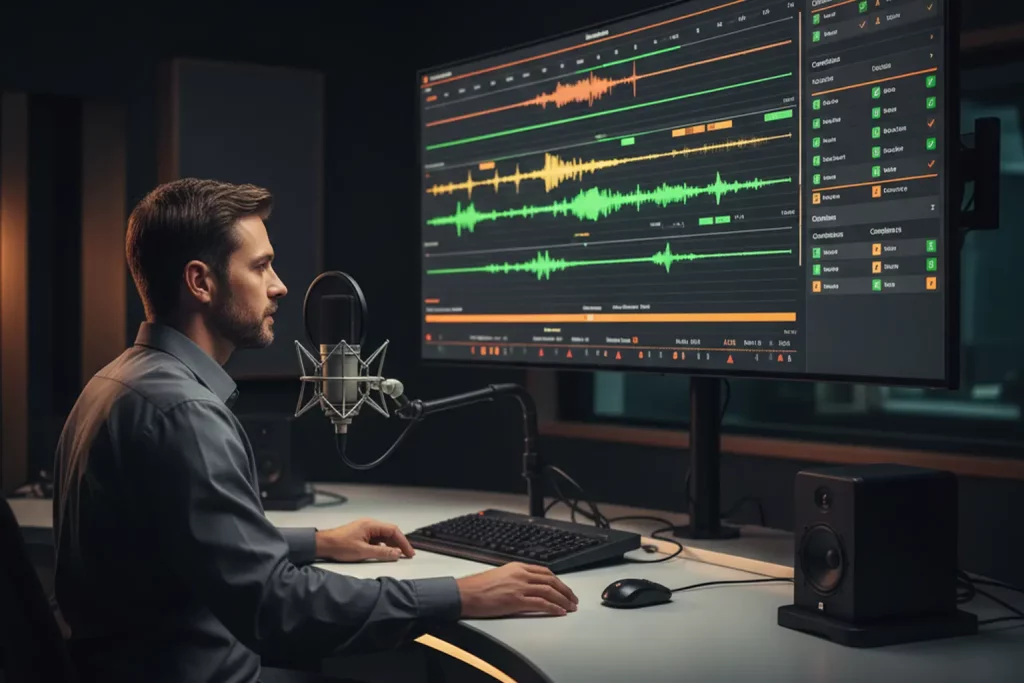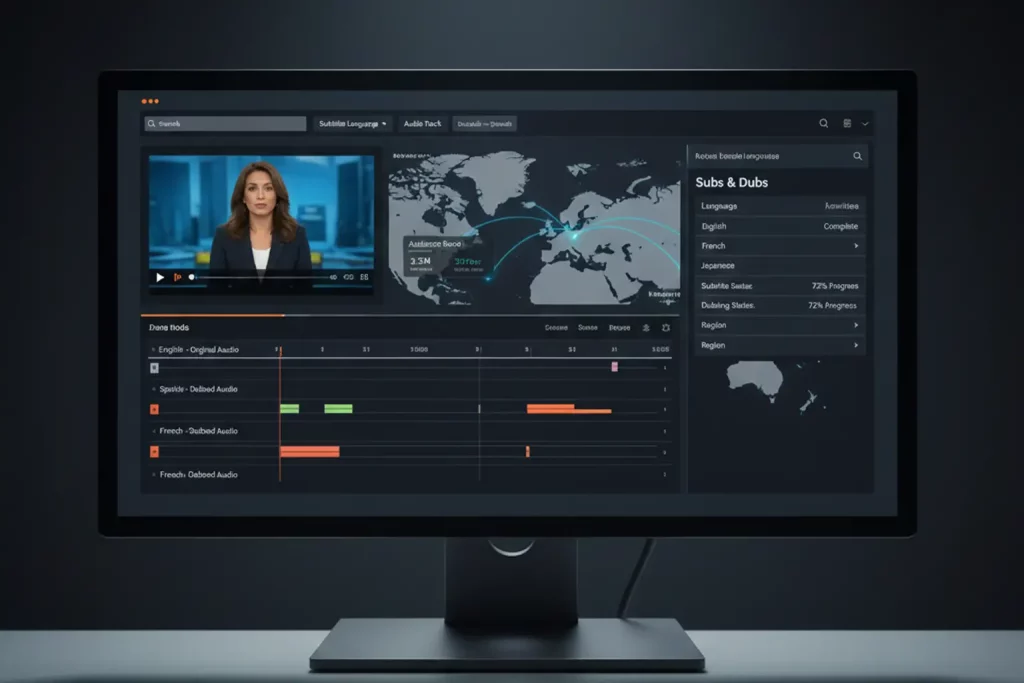In today’s fast-paced broadcasting landscape, media monitoring has become crucial for organizations aiming to maintain an edge over the competition and stay connected with their audience. The significance of media monitoring extends beyond just tracking mentions; it encompasses brand reputation management, crisis management, market intelligence, and more. Let’s delve into the benefits, methods, and tools involved in media monitoring within the broadcasting industry, providing a comprehensive understanding of its importance.
What is Media Monitoring?
Media monitoring involves tracking and analyzing media content to gather insights about various topics, brands, or trends. In the broadcasting industry, this means collecting data from television and radio broadcasts to understand how a brand or topic is being discussed and perceived. This data helps organizations understand public sentiment and adjust their strategies accordingly.
Historical Context
Traditionally, media monitoring relied on manual efforts—teams of people would watch or listen to broadcasts, making notes of relevant mentions. Technological advancements have made media monitoring more sophisticated, utilizing automated tools and machine learning algorithms to provide real-time insights. This evolution has made media monitoring more efficient and accurate, allowing quicker responses to media mentions.
Enhancing Media Monitoring with MonitorIQ
Tools like MonitorIQ provide comprehensive media monitoring solutions tailored to the broadcasting industry. This tool offers robust features that streamline the monitoring process. It combines advanced technology with user-friendly interfaces to enhance the monitoring experience.
By using advanced media monitoring tools, organizations can improve the efficiency and accuracy of their media tracking efforts. Key benefits include:
- Automated Data Collection: Reducing the manual effort involved in tracking broadcasts.
- Comprehensive Analysis: Offering deep insights through advanced data analysis techniques.
- User-Friendly Interface: Simplifying the process of navigating through vast amounts of data.
Ready to experience the future of Media Monitoring? Schedule a free demo today!
Importance of Media Monitoring
Brand Reputation Management
Effective media monitoring is vital in maintaining and enhancing a brand’s reputation. Companies can gauge public perception and quickly address any negative comments or misinformation by keeping track of how a brand is mentioned across different broadcasting channels. This proactive approach helps build a positive brand image and maintain trust with the audience.
Crisis Management
Rapid response is crucial in the event of a PR crisis. Media monitoring allows organizations to identify potential issues before they escalate and implement strategies to mitigate any damage. This proactive approach can be the difference between a minor hiccup and a full-blown crisis. By addressing issues promptly, companies can prevent long-term damage to their reputations.
Market Intelligence
Media monitoring provides invaluable insights into market trends and competitor activities. Companies can stay informed about industry developments, competitor strategies, and consumer preferences by analyzing broadcasts. This intelligence can inform strategic decisions and help capitalize on emerging opportunities. Staying ahead and understanding market dynamics gives companies a significant competitive advantage.
Methods of Media Monitoring
Traditional vs. Digital Media Monitoring
Traditional Media Monitoring
Traditional media monitoring involves manual tracking of radio and television broadcasts. Despite being labor-intensive, it offers a human touch that can capture nuances automated systems might miss. This method, although slower, can provide deeper insights into the context of media mentions.
Digital Media Monitoring
Digital media monitoring utilizes automated tools to scan and analyze real-time broadcasts. It offers scalability and speed, making it easier to process large data efficiently. Advanced technologies such as natural language processing and sentiment analysis enhance the accuracy and depth of insights obtained from digital monitoring.
Tools and Technologies
Various media monitoring tools cater specifically to the broadcasting industry. These tools can track mentions, analyze sentiment, and provide comprehensive reports. Some notable features include keyword tracking, sentiment analysis, and competitive benchmarking. Companies can streamline their media monitoring processes using these tools and gain actionable insights.
Data Collection and Analysis
Data collection involves capturing audio and video content from broadcasts, transcribing it, and identifying relevant mentions. Data analysis then utilizes this information to generate actionable insights. Techniques such as sentiment analysis and trend analysis help organizations understand the context and impact of media mentions. This comprehensive approach ensures that companies are well-informed about their media presence.
Key Benefits of Media Monitoring
Enhanced Decision-Making
Leaders can make informed decisions based on real-time data and trends provided by media monitoring. For example, if a competitor receives negative coverage, an organization can capitalize on this by highlighting its strengths through strategic messaging. Access to up-to-date information allows for agile and effective decision-making.
Customer Engagement
Understanding how a brand is discussed in the media helps craft messages that resonate with the audience. Effectively engaging with customers means addressing their concerns, appreciating their positive feedback, and continuously improving based on media insights. This engagement fosters stronger relationships and loyalty among the customer base.
Content Strategy Optimization
Media monitoring helps tailor content strategies by identifying trending topics and audience preferences. For example, if a particular topic is gaining traction, companies can create related content to better engage their audience. This approach ensures that content is relevant and engaging, enhancing its impact.
Challenges in Media Monitoring
Data Overload
Managing and making sense of this data can be overwhelming with the sheer volume of daily media content. Organizations must have the right tools and processes to filter relevant data and derive meaningful insights. Effective data management practices are crucial for handling this challenge.
Accuracy and Relevance
Ensuring the data collected is accurate and relevant is crucial for effective media monitoring. Automated tools can sometimes miss context or misinterpret sentiment, necessitating manual oversight to maintain data quality. Combining automated tools with human expertise can enhance the accuracy and reliability of insights.
Resource Allocation
Effective media monitoring requires dedicated resources. Organizations must allocate the necessary budget and personnel to manage and analyze media data, which can be a significant investment. Ensuring that resources are used efficiently is key to maintaining an effective media monitoring strategy.
Best Practices for Effective Media Monitoring
Setting Clear Objectives
Define what you aim to achieve with media monitoring. Whether it’s tracking brand mentions, analyzing competitor activities, or understanding market trends, having clear objectives helps focus efforts and measure success. Clear goals guide the monitoring process and ensure efforts align with organizational priorities.
Choosing the Right Tools
Select tools that fit your specific needs. Consider factors like ease of use, scalability, and the ability to integrate with other systems. The right tools can significantly enhance the efficiency and effectiveness of media monitoring. Investing in high-quality tools is essential for obtaining reliable and actionable insights.
Regular Review and Adjustment
Media monitoring is not a one-time effort; it requires continual review and adjustment. Regularly assess your media monitoring strategies and tools to ensure they align with your objectives and deliver the desired insights. Continuous improvement is key to maintaining the effectiveness of media monitoring efforts.
How Advanced Tools Can Help
Advanced tools offer capabilities like real-time tracking, sentiment analysis, and comprehensive reporting. They can handle large volumes of data and provide actionable and timely insights, enabling organizations to stay ahead in the fast-paced media landscape.
Feature Highlights
Key features of advanced media monitoring tools include:
- Real-Time Tracking: Immediate alerts on relevant media mentions.
- Sentiment Analysis: Understanding the tone of media mentions (positive, negative, neutral).
- Competitive Benchmarking: Comparing your media presence against competitors.
- Custom Reporting: Tailored reports that highlight key insights and trends.
Case Study: Broadcasting Company’s Successful PR Crisis Management with Advanced Media Monitoring
A leading broadcasting company faced a potential PR crisis when negative mentions about its latest program surfaced on social media and news platforms. Realizing the gravity of the situation, the company turned to advanced media monitoring tools to manage and mitigate the fallout.
Early Detection and Swift Action
By leveraging state-of-the-art media monitoring tools, the company could detect these negative mentions early, often within minutes of their appearance. The tools provided real-time alerts and detailed analytics, allowing the PR team to identify the sources and scale of the negativity quickly. This early detection was crucial in preventing the issue from escalating further.
Strategic Response and Issue Management
With insights from the media monitoring tools, the company was able to craft a well-informed response strategy. They promptly addressed the concerns the public raised, issuing statements that acknowledged the issues and provided clear plans for rectification. The tools also helped track the audience’s sentiment, allowing the company to adjust its messaging based on real-time feedback.
Turning the Situation Around
The company’s proactive approach not only mitigated the immediate damage but also helped turn the situation around. The company shifted public perception by addressing the criticisms head-on and demonstrating transparency. The negative narrative was gradually replaced by positive coverage as the media and the public acknowledged the company’s swift and thoughtful responses.
Positive Brand Perception
Ultimately, the broadcasting company successfully transformed a potential PR disaster into an opportunity to enhance its brand image. Advanced media monitoring tools were pivotal in this turnaround, proving their value in modern PR crisis management. The company emerged from the situation with a strengthened reputation and a clearer understanding of the benefits of early detection and strategic response.
This case study underscores the practical benefits of utilizing advanced media monitoring tools in managing PR crises. Their ability to provide timely insights and facilitate effective response strategies can significantly impact brand perception and maintain a positive public image.
Conclusion
Media monitoring is an indispensable tool in the broadcasting industry, offering significant benefits in brand reputation management, crisis management, and market intelligence. Despite the challenges associated with data overload, accuracy, and resource allocation, setting clear objectives, choosing the right tools, and regularly reviewing strategies can optimize media monitoring efforts. Advanced media monitoring tools enhance these processes, providing real-time insights and enabling organizations to stay ahead of the curve.
As the broadcasting landscape evolves, embracing effective media monitoring strategies will be crucial for maximizing brand success. Consider incorporating advanced tools into your media monitoring initiatives to leverage their full potential and drive your brand forward. By understanding and implementing effective media monitoring strategies, organizations can protect their brand reputation and gain a competitive edge in the ever-changing broadcasting industry.
Digital Nirvana: Empowering Knowledge Through Technology
Digital Nirvana stands at the forefront of the digital age, offering cutting-edge knowledge management solutions and business process automation.
Key Highlights of Digital Nirvana –
- Knowledge Management Solutions: Tailored to enhance organizational efficiency and insight discovery.
- Business Process Automation: Streamline operations with our sophisticated automation tools.
- AI-Based Workflows: Leverage the power of AI to optimize content creation and data analysis.
- Machine Learning & NLP: Our algorithms improve workflows and processes through continuous learning.
- Global Reliability: Trusted worldwide for improving scale, ensuring compliance, and reducing costs.
Book a free demo to scale up your content moderation, metadata, and indexing strategy for your media assets with minimal effort and get a firsthand experience of Digital Nirvana’s services.
FAQs:
1. What is media monitoring in the broadcasting industry?
Media monitoring involves tracking and analyzing television and radio broadcasts to gather insights about how a brand or topic is discussed and perceived.
2. Why is media monitoring important for brand reputation management?
Media monitoring helps organizations gauge public perception and quickly address negative comments or misinformation, thereby maintaining and enhancing their brand’s reputation.
3. How can media monitoring aid in crisis management?
By identifying potential issues early, media monitoring allows organizations to respond rapidly and implement strategies to mitigate damage, preventing a minor issue from escalating into a full-blown crisis.
4. What are the key benefits of using advanced media monitoring tools?
Advanced tools offer real-time tracking, sentiment analysis, competitive benchmarking, and custom reporting, which enhance the efficiency and accuracy of media monitoring efforts.
5. What challenges are associated with media monitoring?
Challenges include managing the vast amount of data produced daily, ensuring data accuracy and relevance, and allocating the necessary resources to monitor and analyze media content effectively.



